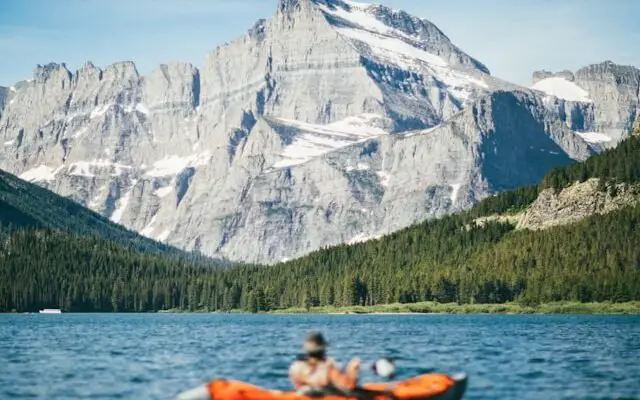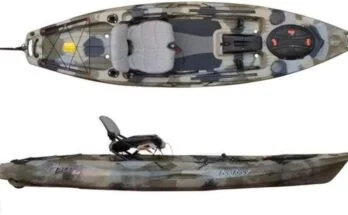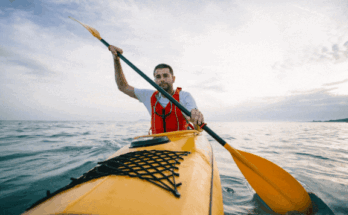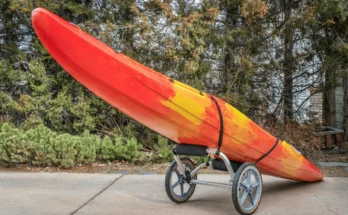Kayaking is attractive and almost all like to do as both families and fitness fanatics. It is an opportune among-the outdoor activities of birding, fishing, and for photo taking.
But perhaps you’re wondering When Does Kayaking Season Start? Or when does the kayaking season end?
Do you still dream of getting back out on your kayak and going fishing to a location you’ve had in your mind for a long time?
Do you still dream of getting back out on your kayak and going fishing to a location you’ve had in your mind for a long time? Indeed, a lot of students like you are facing the same issue.
This is a thing we’ll do in this article, guys!
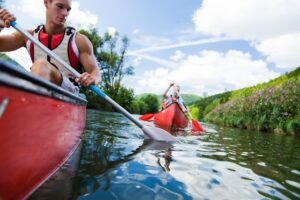
When Does Kayak Season Start?
This phrase is region-dependent, which means that in some regions it may differ.
Water kayaking can be practiced in the southern US, springs of warm regions, as well as in late spring of cold climates all year around
You could kayak in colder waters if it is something you like doing or are comfortable doing it, however. Kayaks can be brought and used where necessary once the ice is melted and the water is not frozen.
The first thing you need to know if you are in the plan of kayaking in winter or cold water for safety is called.
One of the reasons is that it’s generally sunny with a warm temperature. Rather than paddling at noon when all sights and densities are really close, you will better enjoy kayaking in the midday.
Sunbathing in the city is not a wise idea since the sun is quite intense. If you prefer mild temperature, come out early morning or before the sunset.
Do not forget about the embankment in anticipation of the fabulous kayaking, even in the absence of rain. Summer showers may be beautiful but they can also bring meteorological marvels of life like birds out which would definitely make a sunny day more interesting.
Special weather conditions as thunderstorms and strong winds are the only force capable of preventing trips in kayaks. Actually, this is not reason for any worry because you may be sure to have a not-great day even if the sun shines.
Best Weather Conditions For Kayaking
Being a local resident is by default a better position if you want to enjoy your expedition in the water familiar to you. Nevertheless, there is a lot of aspects you have to take into note while kayaking on perfect weather conditions.
Wind Direction And Speed
Let me delve into two weather factors that will make the most profound mark on your kayaking experience, namely wind speed and direction.The wind may steer your kayak from whatever course you’re paddling and this can add to your problems. If you find kayaking interesting, the ideal weather would be no wind or wind almost non-existent. Knowing what to expect, as a beginner, will greatly help you enjoy kayaking.
Water Temperature
When to Start Kayaking is it. Among the many aspects of aquatic life, it is water temperature that has a special role to play. That is what starts with the fact that on the other’s hand, chilliness to you could be pleasant, genuine to someone else. Be careful water can be one of the most significant killer danger associated with kayaking.However, there’s more than just rule of thumb to stay warm when kayaking — there is an exact mathematical formula that does the job. This could be attested by one’s own experience with kayaking – when water temperature is above 70 degrees Fahrenheit, kayaking becomes considerably easier and much more enjoyable.
The 120-Degree Rule
In addition to the 120-degree rule, you can also tell whether it’s too cold in kayaking or need to take measurements to prevent further cold in kayaking. If when you add the temperatures of the air and the water in result you get a degree less than 120 degrees then it would be a great idea that you think about using wetsuit and dry suits. Otherwise, if you happen to get stuck in a cold water and be unable to get out of your capsized canoe, hypothermia will most likely be the consequence.
While here, real situation, you will be fine, if water temperature will be 70 degrees and the air will be 55 degrees, but if both water and air are 55 degrees, you will need wetsuit or dry suit.
Can You Kayak All Year Round?
Certainly, you can kayak all the year round – otherwise with a little willingness to spend some time for it.
Of course, the best period to go kayaking is in the summer. You feel that as long as the weather is fine, almost everybody prefers to go kayaking during the warm season as compared to the winter time.
But you’d be kind of astounded at how stunning some places can appear in the depths of winter.
Norway is my reference point since I understand what I am talking about. The extraordinary experience is covered by conspicuous purewater and a rare privilege to see aurora – the light of which is a thing you cannot pronounce in a thousand years.
That’s why the number one rule for kayakers – no matter the season – is:
You need to clothing for the water – not the weather.
Sartorial protection is a must – whether howling winds or blistering sun, humidity or torrential rain.
For instance, the fact that the horizon is totally filled with warm glow does not guarantee that the water is also warm in the meantime. The above is so true in particular in the spring.
Air starts off at its higher temperatures pretty quickly; but water due to its higher heat capacity, usually takes a bit more time to destroy this layer.
Besides coming by the evaporation of perspiring made worse by the un-people heat, which, in turn, drop the body temperature very fast, hence water mores dangerous when it comes to cold water.
I could not be more serious when I say obviously inconvenient and “dangerous” at the same time. The two main risks related with cold water exposure are:
- Cold Shock –Never underestimate cold water. It could be the last person on the planet but when you are freezing in the water after the capsize, even the one person on the planet is not going to save you.Your hateful adventurous spirit can cause you to plunge into the water below 60 degrees of Fahrenheit, and you will face the unbelievable feeling of breathlessness and so you will be unable to move. Furthermore, just after a short period of time with water, hypothermia will take you.
- Hypothermia – Your body temperature goes lower and lower and you begin to shiver and you then lose sensitivity of your limps reaching to the level that you are not able to think improperly and feel extreme exhaustion and drowsiness – which all together makes it hard enough to survive in the water.
One way to minimize these risks is to choose the right clothes for kayaking, and your choice will, clearly, depend on the season:
Summer Kayaking
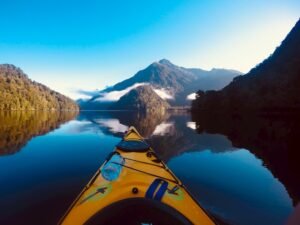
I can imagine nothing better than spending a Sunday afternoon kayaking on our beautiful rivers. The weather will no longer bring you down since it is in your direction,
and therefore you needn’t occupy yourself with dressing. No worries, whatever! Shorts and a T-shirt (and even bathing suit maybe, who knows?) is totally fine.
Although sunbeams will play their role as well, excessive sun can be a serious problem here.
Thus, wearing a sunny hat, sun-glasses and sunscreen with of course keeping your system hydrated is a good idea. And the love of God go away,
but never take your kayak during a busy summer. It is a sin to get in the sun in your yak and wait at 90 degrees – you risk heat stroke.
Winter Kayaking
Cold-weather kayaking is a whole different level of extreme – and there’s a high chance you may meet your Maker if you don’t prepare for it:
- Dress a dry suit or a wet suit. Given that you are canoeing in freezing waters, and it’s below 40 degress, you would need more than just a wet suit. The has only one way to reduce the risk of table shock and hypothermia, and it is wearing a dry suit.
- Add thermal layers for insulation. Dry suit is a relatively safe thing – one who wears this suit not does not warm at all. Despite that, you still have to add more layer-up of insulation beneath so that you keeping your body heat. The more recommended layers are fleece and Merino wool and then a moisture wicking layer.
- Wear a hat. In the case of some paddling jackets the hood comes with them. And if yours doesn’t, I say you can try a beanie – a more updated and fashionable form of the balaclava type neoprene hat but just a tad upgraded.
- Consider wearing neoprene gloves. As for your protection and warmth, you can further improve your tools (pogies) with mittens you attach to your paddle.
- Don’t forget about footwear. Getting neoprene boots is advisable in conditions like icy terrain and extreme cold – in short, harsh natural environment at all times.
- Use a spray skirt. I’ll also add insulation to the lining which will help prevent water getting in. My body too won’t freeze as it will be trapped warm air inside.
Determining what to wear is only part of the equation; here are a few more tips on how to stay safe out there:
- Never go kayaking alone. With different problems, there is security in number. it is better to have witnessed the upside down and been helped to recover.
- Inform someone about your plans. making timetable, destination, and file a float plan when you back or not – are the advice.
- Carry a communication device onboard. A smartphone is a must, but I still encourage an efficient VHF radio as well as a personal emergency beacon device for a safe trip into the great outdoors.
- Equip your kayak with navigational lights. Sunset occurs before sixty p.m. and at dawn it’s dark in winter requires you to watch out and be seen at the same time.
Kayaking In Mild Weather: Spring & Autumn
Yes! We are in quest of two contrasting seasons, but even so, autumn and spring share one most obvious similarity which is the typical mild weather and quite large percentages of rainy days.
- The days often start out chilly but warm up as noon methods, which is why I usually recommend layering up:
Avoid even thin wetsuits with thicknesses below 4 millimeters, per matching suit and a pullover definitely are better accessory that can harmonize with the outer one. - If the weather is not too bad and you don’t have to wear a dry suit, you can go with a long-sleeve rash-guard plus a bonus fleece jacket and with that a waterproof paddling jacket or a windbreaker to cover up.
- But if there’s too much cold in the water, go with the dry suit, which can be coupled with quick-drying synthetic materials for your base layer (long underwear and form-fitting T-shirt). In several layers (fleece or Merino wool) your mid-layer can be placed.
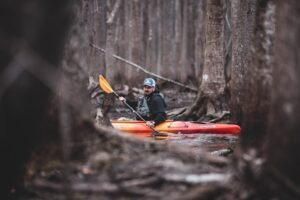
When Does Kayaking Season Start: Conclusion
So, When Does Kayaking Season Start?
The answer is that nobody is quite sure. Make your own choice after carefully considering all the things mentioned above.
Remember to plan, be safe, and bring a friend.
If you venture out into the winter waters, it’s usually best to stick by the rule “the more, the merrier.”

